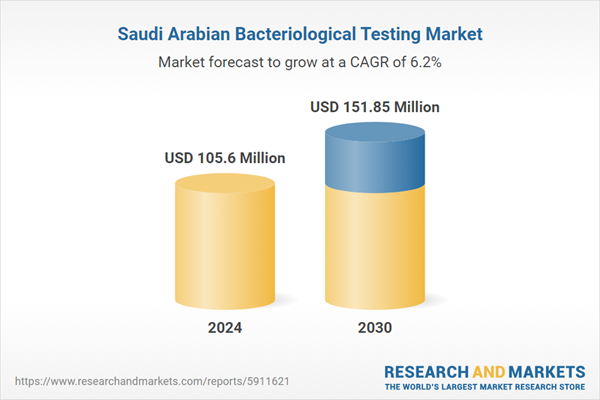Speak directly to the analyst to clarify any post sales queries you may have.
10% Free customizationThis report comes with 10% free customization, enabling you to add data that meets your specific business needs.
The adoption of rapid and automated microbiological testing systems is enhancing the accuracy and efficiency of bacteriological diagnostics, reducing turnaround times and improving detection capabilities. Despite this positive outlook, the industry faces significant challenges, including a shortage of highly skilled professionals to operate sophisticated testing equipment and the high capital investment required to develop and sustain advanced diagnostic infrastructure. These issues underscore the importance of targeted workforce development initiatives and increased investment in technology upgrades.
Saudi Arabia’s bacteriological testing sector is well-positioned for long-term growth, supported by continued innovation in testing methodologies, stricter regulatory enforcement, and a growing focus on public health. Industry stakeholders are expected to invest in state-of-the-art diagnostic technologies and capacity-building programs to meet evolving market demands and regulatory standards.
Key Market Drivers
Rising Incidence of Bacterial Infections
The growing prevalence of bacterial infections is a major driver of market expansion in Saudi Arabia. A study at Hail Hospital highlighted pneumonia as the most common infection (27.2% of cases), followed by urinary tract infections (20.2%) and bloodstream infections (10.5%). These figures reflect the significant public health burden posed by bacterial infections and emphasize the need for improved diagnostic capabilities and infection control strategies in healthcare settings.The increasing occurrence of foodborne illnesses, hospital-acquired infections (HAIs), antimicrobial resistance (AMR), and waterborne diseases is intensifying the demand for advanced diagnostic solutions across sectors such as healthcare, food and beverage, water treatment, and pharmaceuticals.
Foodborne bacterial infections are particularly concerning due to the widespread consumption of processed and imported foods, coupled with the growth of the foodservice sector. Pathogens such as Salmonella, Escherichia coli (E. coli), Listeria monocytogenes, and Campylobacter are major contributors to foodborne illnesses, necessitating stringent bacteriological testing throughout food production and distribution chains.
Key Market Challenges
Slow Turnaround Times
One of the primary challenges impeding market growth is the slow turnaround time associated with traditional bacteriological testing methods. In sectors such as healthcare and food production, timely results are critical for effective decision-making and risk mitigation. However, conventional testing procedures are often time-intensive, with results taking several days or even weeks.This delay reduces the appeal of traditional bacteriological testing among prospective clients who prioritize speed and efficiency. Consequently, alternative diagnostic methods such as Polymerase Chain Reaction (PCR) and other rapid testing technologies are gaining traction, offering quicker and more resource-efficient solutions. Unless conventional testing methods can significantly reduce turnaround times, their demand may continue to decline.
Key Market Trends
Technological Advancements in Bacteriological Testing
Innovations in bacteriological testing technologies are expected to significantly accelerate market demand in Saudi Arabia. These advanced methods enhance testing accuracy, speed, and overall efficiency - attributes that are vital across industries such as healthcare, agriculture, and food and beverages.In the healthcare sector, faster and more accurate bacterial detection plays a key role in curbing infection spread and improving public health outcomes. Similarly, in agriculture, these technologies contribute to monitoring soil and crop health, while the food and beverage industry benefits from improved food safety assurances.
Saudi Arabia’s strategic push toward industrial modernization, in alignment with the Vision 2030 initiative, provides a strong foundation for the integration of cutting-edge diagnostic technologies. Rising public and industry awareness of the importance of bacteriological testing in preventing disease outbreaks and ensuring population well-being is further driving this trend.
Key Market Players
- Bureau Veritas Saudi Arabia
- Intertek Saudi Arabia
- Eurofins KSA
- TÜV SÜD
- ALS Arabia
Report Scope:
In this report, the Saudi Arabia Bacteriological Testing Market has been segmented into the following categories, in addition to the industry trends which have also been detailed below:Saudi Arabia Bacteriological Testing Market, By Bacteria Type:
- Coliform
- Salmonella
- Campylobacter
- Listeria
- Legionella
- Others
Saudi Arabia Bacteriological Testing Market, By Technology:
- Traditional Technology
- Rapid Technology
Saudi Arabia Bacteriological Testing Market, By Component:
- Instruments
- Test Kits
- Reagents & Consumables
Saudi Arabia Bacteriological Testing Market, By End User:
- Food & Beverage
- Water
- Pharmaceuticals
- Others
Saudi Arabia Bacteriological Testing Market, By Region:
- Western Region
- Central Region
- Southern Region
- Eastern Region
- Northern Region
Competitive Landscape
Company Profiles: Detailed analysis of the major companies present in the Saudi Arabia Bacteriological Testing Market.Available Customizations:
With the given market data, the publisher offers customizations according to a company's specific needs. The following customization options are available for the report.Company Information
- Detailed analysis and profiling of additional market players (up to five).
This product will be delivered within 1-3 business days.
Table of Contents
Companies Mentioned
- Bureau Veritas Saudi Arabia
- Intertek Saudi Arabia
- Eurofins KSA
- TÜV SÜD
- ALS Arabia
Table Information
| Report Attribute | Details |
|---|---|
| No. of Pages | 85 |
| Published | April 2025 |
| Forecast Period | 2024 - 2030 |
| Estimated Market Value ( USD | $ 105.6 Million |
| Forecasted Market Value ( USD | $ 151.85 Million |
| Compound Annual Growth Rate | 6.2% |
| Regions Covered | Saudi Arabia |
| No. of Companies Mentioned | 5 |









